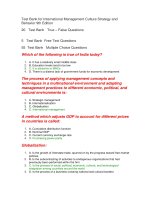International interviewing and counseling 9th ivey chapter 05
Bạn đang xem bản rút gọn của tài liệu. Xem và tải ngay bản đầy đủ của tài liệu tại đây (301.65 KB, 24 trang )
Intentional Interviewing and Counseling:
Facilitating Client Development in a
Multicultural Society
9th Edition
Allen E. Ivey
Mary Bradford Ivey
Carlos P. Zalaquett
Copyright © 2018 Cengage Learning. All Rights Reserved.
Chapter 5
Questions:
Opening
Communication
Copyright © 2018 Cengage Learning. All Rights Reserved.
Chapter Goals and Competency Objectives (slide 1 of 2)
Awareness and Knowledge
▲ Understand the two key styles of questioning: open and closed questions.
▲ Choose the question stem and style that are most likely to achieve a useful anticipated result that
clarifies the client’s story. For example, what questions often lead to talk about facts, how
questions to feelings or process, and why questions to reasons. Could/would questions tend to be
the most open.
Copyright © 2018 Cengage Learning. All Rights Reserved.
Chapter Goals and Competency Objectives (slide 2 of 2)
Skills and Action
▲
Draw out and enrich client stories by bringing out a more complete description, including background information and
needed details.
▲
Open or close client talk, intentionally, according to the individual needs of the client.
▲
Balance discussion of clients’ concerns in a more positive way using the positive asset search, strength emphasis,
positive psychology, and wellness.
▲
Use questions in a culturally sensitive and respectful way.
Copyright © 2018 Cengage Learning. All Rights Reserved.
Introduction: Questions (slide 1 of 5)
The Case of Benjamin
Benjamin is in his junior year of high school, in the middle third of his class. In this school, each
student must be interviewed about plans after graduation—work, the armed forces, or college.
You are the high school counselor and have called Benjamin in to check on his plans after
graduation. His grades are average. He is not particularly verbal or talkative, but he is known as a
“nice boy.”
Copyright © 2018 Cengage Learning. All Rights Reserved.
Introduction: Questions (slide 2 of 5)
The Value of Questions
▲ Systematic framework for directing the interview.
▲ Open new areas for discussion.
▲ Pinpoint and clarify issues.
▲ Aid in self-exploration.
Copyright
© 2018
Cengage
Learning.
AllAll
Rights
Reserved.
Copyright
© 2018
Cengage
Learning.
Rights
Reserved.
Introduction: Questions (slide 3 of 5)
Types of Questions
▲Open
Can’t be answered in a few words.
Facilitate deeper exploration of client issues.
Typically begin with what, how, why, or could/would.
▲Closed
Enable you to obtain specifics and can be answered in a few words.
Often begin with is, are, or do.
Copyright © 2018 Cengage Learning. All Rights Reserved.
Introduction: Questions (slide 4 of 5)
Open Questions: Open questions often begin with who, what, when, where, or
Anticipated Client Response: Clients provide more details and talk more in
why. Closed questions may start with do, is, or are. Could, can, or would
response to open questions. Could, would, and can questions are often
questions are considered open but have the advantage of being
the most open of all, because they give clients the choice to respond
somewhat closed, giving more power to the client, who can more easily
briefly (“No, I can’t”) or, much more likely, explore their issues in an open
say that he or she doesn’t want to respond.
fashion.
Closed Questions: Closed questions may start with do, is, or are.
Anticipated Client Response: Closed questions may elicit specific information
but may close off client talk.
Effective questions encourage more focused client conversations with more pertinent detail and less wandering.
Copyright © 2018 Cengage Learning. All Rights Reserved.
Introduction: Questions (slide 5 of 5)
▲
Some theorists and many practitioners raise important issues around the use of questioning.
They maintain questions are best learned after expertise is developed in the reflective listening skills (Chapters 6 and 7).
Also, some students or trainees will like using questions so much that they will not give enough attention to critical
listening skills.
▲
Excessive use of questions takes the focus from the client and gives too much power to the interviewer.
Your central task in this chapter is to find your own balance in using questions in the interview.
Copyright © 2018 Cengage Learning. All Rights Reserved.
Awareness, Knowledge, and Skills: Questions for Results (slide 1
of 9)
▲ Clients do not always provide you with important information, and sometimes the only way to obtain it is by
asking questions.
For example, the client may talk about being depressed and unable to act.
▲ The client’s response to the open question “What important things are happening in your life right now or
with your family?” might reveal that a separation or divorce is about to occur, that a job has been lost, or that
some other important issue underlies the client’s depression.
▲ Your original assessment of the client’s condition as classical clinical depression may be modified by what is
occurring in the client’s life, and treatment may take a different direction.
Copyright © 2018 Cengage Learning. All Rights Reserved.
Awareness, Knowledge, and Skills: Questions for Results
(slide 2
of 9)
▲ With verbal clients and a comfortable relationship, the open question facilitates free discussion
and leaves plenty of room to talk.
Examples
“What would you like to talk about today?”
“Could you tell me what prompted you to see me?”
“How have things been since we last talked?”
▲ With a less talkative client, it may be best to start a session with informal conversation about
weather or a current event of interest to the client.
Copyright © 2018 Cengage Learning. All Rights Reserved.
Awareness, Knowledge, and Skills: Questions for Results (slide 3 of 9)
The first word of a question stem often, but not always, results in anticipated outcomes.
First Words
Elicit
WHAT?
Facts and information (“What happened?”)
WHY?
Discussion of reasons (“Why is that meaningful to you?”)
HOW?
Exploration of process or feeling emotion (“How could that be explained?”)
COULD?
CAN?
General framing or summary (“Could you tell me more about your situation?”; “Would
you give me a specific example?”; “Can you tell me what you’d like to talk about today?”)
WOULD?
Copyright © 2018 Cengage Learning. All Rights Reserved.
Awareness, Knowledge, and Skills: Questions for Results
(slide 4
of 9)
▲To help the session start again and keep it moving, ask an open question on a topic
the client presented earlier in the session.
“Could you tell me more about that?”
“How did you feel when that happened?”
“Given what you’ve said, what would be your ideal solution?”
“What might we have missed so far?”
“What else comes to your mind?”
Copyright © 2018 Cengage Learning. All Rights Reserved.
Awareness, Knowledge, and Skills: Questions for Results
of 9)
▲Empathy requires that you understand specifically what your client is saying.
▲Concreteness is key in empathic understanding.
▲Seek specifics and avoid vague generalities.
▲Counselors and therapists are interested in specific feelings, thoughts, and
examples of actions.
Copyright © 2018 Cengage Learning. All Rights Reserved.
(slide 5
Awareness, Knowledge, and Skills: Questions for Results
(slide 6
of 9)
▲Examples of open questions that aim for concreteness and specifics might be
“Could you give me a specific example of . . . ?”
“What do you mean by...?”
▲Communication from the counselor needs to be concrete and easy for the client to
understand.
Copyright © 2018 Cengage Learning. All Rights Reserved.
Awareness, Knowledge, and Skills: Questions for Results
(slide 7
of 9)
▲ Positive regard and respect for the client are essential for future growth. This is illustrated in
neuroscience research.
Memories are stored in many sections of the brain.
Negative emotions and feelings originate primarily in the amygdala, deep in the limbic system
of the brain.
Positive emotions are located in many areas, but the nearby nucleus accumbens sends out
signals to the prefrontal cortex, enabling focus on the positive.
Copyright © 2018 Cengage Learning. All Rights Reserved.
Awareness, Knowledge, and Skills: Questions for Results
(slide 8
of 9)
▲Bombardment/grilling. Too many questions may give too much control to the
interviewer and may put clients on the defensive.
▲Multiple questions. Another form of bombardment, throwing out too many
questions at once, may confuse clients. However, it may enable clients to
select which question they prefer to answer.
Copyright © 2018 Cengage Learning. All Rights Reserved.
Awareness, Knowledge, and Skills: Questions for Results
(slide 9
of 9)
▲ Questions as statements. Some interviewers may use questions as a way to sell their own points of
view. If you are going to make a statement, do not frame it as a question.
“Don’t you think it would be helpful if you studied more?” vs “What occurs to you as you think
about improving your grades?”
▲ Why questions can put interviewees on the defensive and cause discomfort. Any question that
evokes a sense of being attacked can cause discomfort and defensiveness.
Copyright © 2018 Cengage Learning. All Rights Reserved.
Observe: Questions in the Interview
▲ What do you think of the meeting between Jamila and Kelly?
▲ What did you learn about the use of open and closed questions?
▲ Was Jamila putting ideas into Kelly’s mind?
▲ What is the effect of using why, how, and could questions?
Copyright © 2018 Cengage Learning. All Rights Reserved.
Multiple Applications of Questions (slide 1 of 4)
▲ The antecedent-behavior-consequence-thoughts-emotions (ABC-TE) framework provides a
comprehensive picture of the client’s experience.
1.
Antecedent: Draw out the linear sequence of the story.
2.
Behavior: Focus on observable concrete actions.
3.
Consequence: Help the client see the result of an event.
4.
Thoughts: Relating to thoughts and cognitions (prefrontal cortex TAP executive system).
5.
Emotions: Relating to emotional regulation involving the limbic system and hormonal impact on the brain and body.
Copyright © 2018 Cengage Learning. All Rights Reserved.
Multiple Applications of Questions (slide 2 of 4)
▲Questions place power with the interviewer.
▲Questions from culturally different interviewers may be met with distrust, and only
grudging answers may be given.
▲Asking too many questions too quickly may promote distrust. “Rapid-fire” questions
may be perceived as grilling.
▲Questions used insensitively can destroy trust.
▲Honor cultural differences.
Copyright © 2018 Cengage Learning. All Rights Reserved.
Multiple Applications of Questions (slide 3 of 4)
▲ Build Trust at the Client’s Pace. A central issue with hesitant clients is trust. Trust building and
rapport need to come first, and your own natural openness and social skills are essential.
▲ Search for Concrete Specifics. If your client is talking in very general terms and is hard to
understand, it often helps to ask questions from the antecedent-behavior-consequence (ABC)
pattern.
Copyright © 2018 Cengage Learning. All Rights Reserved.
Multiple Applications of Questions (slide 4 of 4)
▲Children may require considerable help from the interviewer before they are willing to
share at all.
▲It helps children talk if they have something to do with their hands, such as drawing,
playing with small toys, or playing with a house that includes child and adult figures.
▲Many open questions are too broad for children to understand.
Phrase ABC questions empathically and carefully.
Copyright © 2018 Cengage Learning. All Rights Reserved.
Action: Key Points and Practice of Questions
▲ Act
▲ Value of Questions
▲ Open Questions
▲ Closed Questions
▲ “What Else?” Questions
▲ Promoting Client Elaboration
▲ The Negative Approach
▲ The Positive Approach
▲ Multiple Applications of Questions
▲ Multicultural Issues
Copyright © 2018 Cengage Learning. All Rights Reserved.









